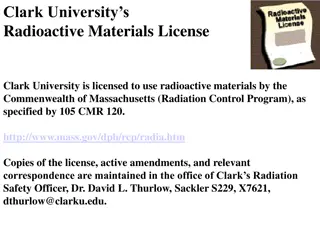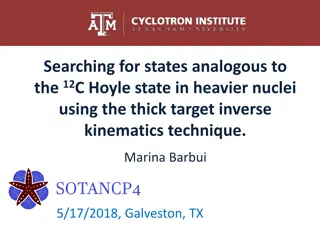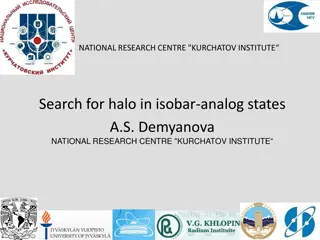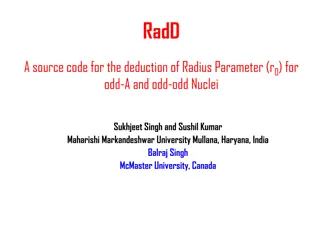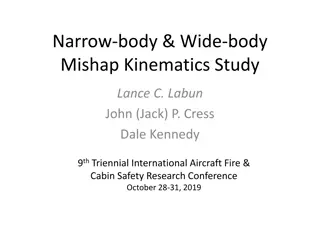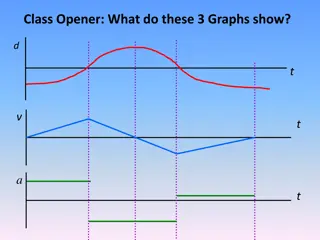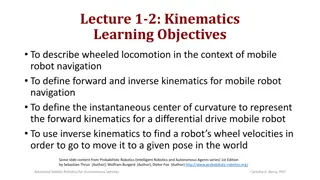Exploring Alpha Cluster Structure in Nuclei Using Thick Target Inverse Kinematics Technique
Exploring the alpha cluster structure of nuclei through the thick target inverse kinematics technique for multiple alpha decays. This study investigates alpha clustering in nuclei, potential alpha condensates, and the application of the inverse kinematics technique in detecting multiple alpha emissions. Experimental setups and data analysis from two experiments at the Cyclotron Institute are discussed, along with events exhibiting alpha multiplicity and the reconstruction of interaction points based on specific assumptions.
- Alpha Clustering
- Nuclei Structure
- Inverse Kinematics Technique
- Experimental Setup
- Cyclotron Institute
Uploaded on Sep 16, 2024 | 0 Views
Download Presentation

Please find below an Image/Link to download the presentation.
The content on the website is provided AS IS for your information and personal use only. It may not be sold, licensed, or shared on other websites without obtaining consent from the author. Download presentation by click this link. If you encounter any issues during the download, it is possible that the publisher has removed the file from their server.
E N D
Presentation Transcript
Exploring the alpha cluster structure of nuclei using the thick target inverse kinematics technique for multiple alpha decays. Marina Barbui June, 23rd, 2015
Alpha clustering in nuclei Estimated limit N = 10 for self-conjugate nuclei(Yamada PRC 69, 024309) Ikeda diagram (K. Ikeda, N. Takigawa, and H. Horiuchi, Prog. Theor, Phys. Suppl. Extra Number, 464, 1968.) Many theoretical works have brought to the picture of alpha cluster nuclei described as a diluted gas of alphas in the lowest S state. (PRL 87, 192501; PRC 75, 037303). Possible existence of alpha condensates in nuclear matter. Experimentally not yet identified in 16O or heavier Look for states analogous to the 12C Hoyle state using the thick target inverse kinematics technique
The Thick target inverse kinematics technique Allows covering a large range of incident energies in the same experiment. In the inverse kinematics, the reaction products are focused at forward angles. Allows measuring reaction products emitted at 0o. This Method has been used several times to study resonant elastic scattering or transfer reactions and is used here for the first time to detect multiple alpha emission. Limit: The position of the interaction point inside the gas has to be reconstructed with some assumptions
Experimental setup Pressurized chamber 4He gas, pressure sufficient to stop the beam before the detectors 4 E-E telescopes 55 um (16x16 strips) -1mm (3-quadrant, 1-16x16 strips) High gain pre amp STRUCK digitizers SIS3316 - 64 E front strips Trigger and Good timing information Good Energy resolution Counts Counts 228Th source 228Th source self coincidence Monitor detector Beam Time(ns) Energy(a.u.) - The other 108 channels go to shapers and ADCs Havar window
2 experiments at Cyclotron Institute 1) Test run with a simplified setup 20Ne @ 10 AMeV on 4He (3.5 Atm) 2) Experiment with the new setup on December 2014 20Ne @ 13AMeV on 4He (5 Atm). Data analysis still in progress, low statistics.
Events with alpha multiplicity 3 20Ne @ 11 AMeV or 13 AMeV +4He 3 alphas in the same event are correlated in time T<15 ns and space 12C1 24Mg* 12C2 Reconstruction of the interaction point with a recursive calculation based on the assumptions: 1) The resonant scattering produces 24Mg * 2) The 3 alphas come from a 12C 3) The other 12C is in the ground state v_ _lab -> Ek(12C1) E*(12C1) = Ecm_ 1+Ecm_ 2+Ecm_ 3+ Qgg (7.26MeV) Since the 3 alphas have similar and quite large energy in the laboratory and travel similar flightpaths the energy loss correction almost cancels out when we calculate 12C excitation energy.
Events with alpha multiplicity 3 Test run 7.65 MeV (0+) - - Total events Uncorrelated events, mixing of 3 random alphas Subtraction Spurious from mixed alphas - 9.6 MeV (3-) December 2014 experiment 11.8 MeV (2-) 12.7 MeV (1+) 7.65 MeV (0+) 11.8 MeV (2-) 12.7 MeV (1+) Relative energy of the three couples of alpha particles -> Tells us if the decay is proceeding through the 8Be ground state. Dalitz Plot -> Information about the energy and momentum of the emitted alpha particles. 9.6 MeV (3-) 16.5 MeV (to be analyzed)
7.65 MeV (0+) Hoyle State decays through 8Begs Experiment Relative energies In agreement with Monte Carlo simulation of the Hoyle state decaying through the 8Be ground state Simulation
9.64 MeV (3-) decays through 8Begs Experiment In agreement with Monte Carlo simulation of a 3- state decaying through the 8Be ground state Simulation
Dalitz Plot (2- at 11.8 MeV) not decaying through 8Begs Fynbo, calculation O.S. Kirsebom, experimental data
Dalitz Plot (1+ at 12.7 MeV) not decaying through 8Begs Fynbo, calculation O.S. Kirsebom, experimental data
Conclusions Using the suggested technique it is possible to study excited states of 12C decaying into 3 alpha particles including the Hoyle state. This study can be extended to 16O, but we need higher statistics. Better system: 32S produced with 28Si beam @ 15AMeV on 4He, looking for the decay into two 16O. 4 events -> possible identification of 16O state analogous to the Hoyle state (candidate 0+ state at Ex 15.1 MeV). Next experiment scheduled: August 2015
Thank you for your attention! M. Barbui, K. Hagel, J. Gauthier, S. Wuenschel, V.Z. Goldberg, H. Zheng, G. Giuliani, G. Rapisarda, E-J. Kim, X. Liu and J.B. Natowitz (Cyclotron Institute, Texas A&M University, College Station, TX, USA ) R. T. deSouza, S. Hudan (Indiana University, Bloomington, IN, USA) D. Fang (Shanghai Institute of Applied Physics (SINAP), Chinese Academy of Sciences, Shanghai, China)



